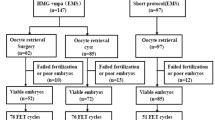Abstract
Purpose
To compare the efficacy of cabergoline (Cb2) and intravenous human albumin (HA) in the prevention of ovarian hyperstimulation syndrome.
Methods
In this randomized controlled trial study, 138 women who were at high risk for developing OHSS were randomly allocated into two groups. In Group one, 20 gr of HA 20% was infused over 1 h. Group two received 0.5 mg per day of Cb2 orally for 7 days, starting on oocyte pickup day. All patients were visited seven and 14 days after oocyte retrieval to determine early clinical or ultrasound evidence of OHSS.
Results
Moderate OHSS was observed in 33 versus 14 cases in the HA and Cb2 groups, respectively, which was significantly different. The number of severe OHSS cases in the HA group was significantly higher than in the Cb2 group (P < 0.001).
Conclusions
Prophylactic oral low dose cabergoline was more effective and less costly than intravenous human albumin in the prevention of OHSS in high-risk patients. (NCT01009567)
Similar content being viewed by others
References
Mathur R, Kailasam CH, Jenkins J. Review of the evidence base of strategies to prevent ovarian hyper stimulation syndrome. Hum Fertil. 2007;10(2):75–85.
Shoham Z, Weissman A, Barasch A, Borenstein R, Schachter M, Insler V. Intravenous albumin for the prevention of severe ovarian hyperstimulation syndrome in an in vitro fertilization program: a prospective, randomized, placebo-controlled study. Fertil Steril. 1994;62:137–42.
Isik AZ, Gokmen O, Zeyneloglu HB, Kara S, Keles G, Gulekli B. Intravenous albumin prevents moderate-severe ovarian hyperstimulation in-vitro fertilization patients: a prospective randomized and controlled study. Eur J Obstet Gynecol Reprod Biol. 1996;70:179–83.
Gokmen O, Ugur M, Ekin M, Keles G, Turan C, Oral H. Intravenous albumin versus hydroxyethyl starch for the prevention of ovarian hyperstimulation in an in-vitro fertilization programme:a prospective randomized placebo controlled study. Eur J Obstet Gynecol Reprod Biol. 2001;96:187–92.
Ben-Chetrit A, Eldar-Geva Y, Gal M, Huerta M, Mimon T, Algur N, Diamant YZ, Margalioth EJ. The questionable use of albumin for the prevention of ovarian hyperstimulation syndrome in an IVF programme: a randomized placebo-controlled trial. Hum Reprod. 2001;16:1880–4.
Isikoglu M, Berkkanoglu M, Senturk Z, Ozgur K. Human albumin does not prevent ovarian hyperstimulation syndrome in assisted reproductive technology program: a prospective randomized placebo-controlled double blind study. Fertil Steril. 2007;88(4):982–5.
Costabile L, Unfer V, Manna C, Gerli S, Rossetti D, Di Renzo GC. Use of intramuscular progesterone versus intravenous albumin for the prevention of ovarian hyperstimulation syndrome. Gynecol Obstet Invest. 2000;50:182–5.
Bellver J, Muñoz EA, Ballesteros A, Soares SR, Bosch E, Simón C, Pellicer A, Remohí J. Intravenous albumin does not prevent moderate-severe ovarian hyperstimulation syndrome in high-risk IVF patients: a randomized controlled study. Human Reprod. 2003;18(11):2283–8.
Chen CD, Chao KH, Yang JH, Chen SU, Ho HN, Yang YS. Comparison of coasting and intravenous albumin in the prevention of ovarian hyperstimulation syndrome. Fertil Steril. 2003;80(1):86–90.
Venetis CA, Kolibianakis EM, Toulis KA, Goulis DG, Papadimas I, Tarlatzis BC. Intravenous albumin administration for the prevention of severe ovarian hyperstimulation syndrome: a systematic review and metaanalysis. Fertil Steril. 2011;95(1):188–96.
Gómez R, Soares SR, Busso C, Garcia-Velasco JA, Simón C, Pellicer A. Physiology and pathology of ovarian hyperstimulation syndrome. Semin Reprod Med. 2010;28(6):448–57.
Gomez R, Gonzalez-Izquierdo M, Zimmermann RC, Novella-Maestre E, Alonso-Muriel I, Sanchez-Criado J. Low-dose dopamine agonist administration blocks vascular endothelial growth factor (VEGF)-mediated vascular hyperpermeability without altering VEGF receptor 2 dependent luteal angiogenesis in a rat ovarian hyperstimulation model. Endocrinology. 2006;147(11):5400–11.
Saylan A, Arioz DT, Koken T, Dilek H, Saylan F, Yilmazer M. Prevention of ovarian hyperstimulation syndrome in a rat model: efficacy comparison between cabergoline and meloxicam. Acta Obstet Gynecol Scand. 2010;89(5):292–9.
Alvarez C, Alonso-Muriel I, García G, Crespo J, Bellver J, Simón C, Pellicer A. Implantation is apparently unaffected by the dopamine agonist Cabergoline when administered to prevent ovarian hyperstimulation syndrome in women undergoing assisted reproduction treatment: a pilot study. Hum Reprod. 2007;22(12):3210–4.
Carizza C, Abdelmassih V, Abdelmassih S, Ravizzini P, Salgueiro L, Salgueiro PT, Jine LT, Nagy P, Abdelmassih R. Cabergoline reduces the early onset of ovarian hyperstimulation syndrome: a prospective randomized study. Reprod BioMed Online. 2008;17(6):751–5.
Sohrabvand F, Ansaripour S, Bagheri M, Shariat M, Jafarabadi M. Cabergoline versus coasting in the prevention of ovarian hyperstimulation syndrome and assisted reproductive technologies outcome in high risk patients. Int J Fertil Steril. 2009;3(1):35–40.
Soliman BS. Cabergoline vs intravenous albumin or combination of both for prevention of the early onset ovarian hyperstimulation syndrome. Middle East Fertil Soc J. 2011;16:56–60.
Golan A, Ron-el R, Herman A, Soffer Y, Weinraub Z, Caspi E. ovarian hyperstimulation syndrome: an update review. Obstet Gynecol Surv. 1989;44:430–40.
Hwang JL, Lin YH, Soew KM. Failure of cabergoline to prevent severe ovarian hyperstimulation syndrome in patients with extremely high estradiol levels. Int J Gynaecol Obstet. 2010;108(2):159–60.
Youssef MA, van Wely M, Hassan MA. Review Can dopamine agonists reduce the incidence and severity of OHSS in IVF/ICSI treatment cycles? A systematic review and meta-analysis. Hum Reprod Update. 2010;16(5):459–66.
Author information
Authors and Affiliations
Corresponding author
Additional information
Capsule In the following report, we found that the oral cabergoline tablet (dostinex) is more effective and less costly than intravenous human albumin in the prevention of Ovarian Hyperstimulation Syndrome.
Rights and permissions
About this article
Cite this article
Tehraninejad, E.S., Hafezi, M., Arabipoor, A. et al. Comparison of cabergoline and intravenous albumin in the prevention of ovarian hyperstimulation syndrome: a randomized clinical trial. J Assist Reprod Genet 29, 259–264 (2012). https://doi.org/10.1007/s10815-011-9708-4
Received:
Accepted:
Published:
Issue Date:
DOI: https://doi.org/10.1007/s10815-011-9708-4




